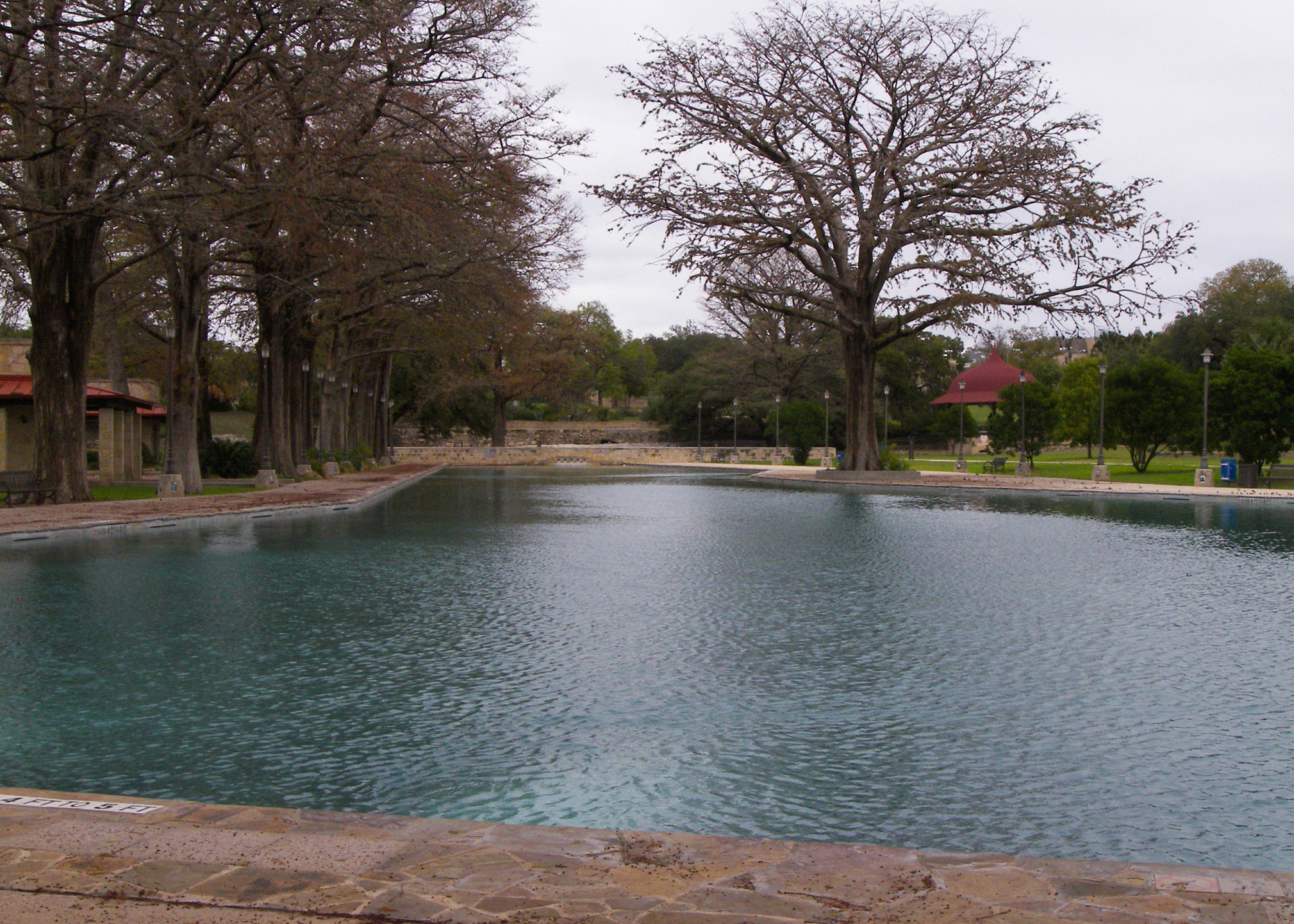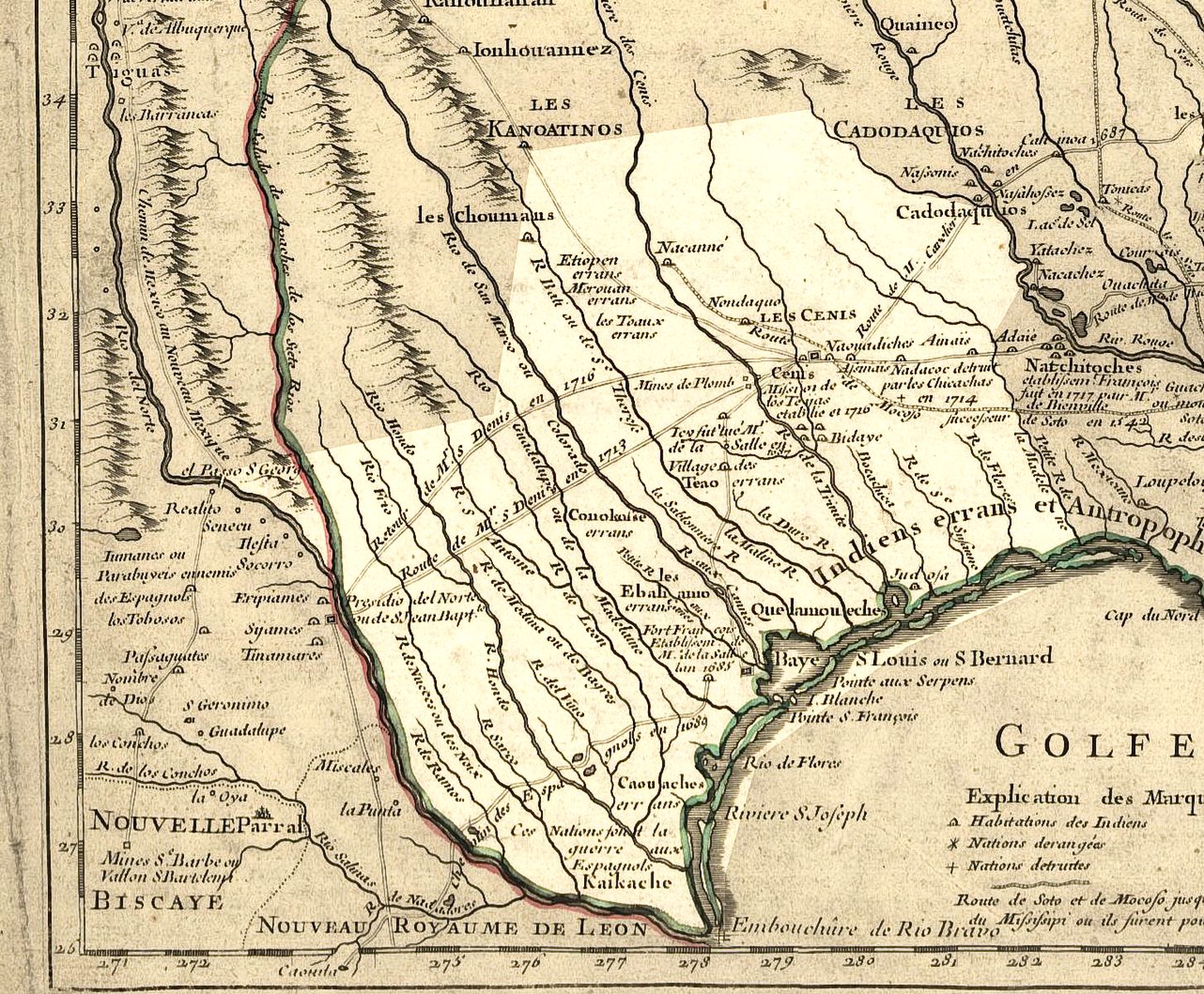|
San Pedro Springs
San Pedro Springs is the name of a cluster of springs in Bexar County, Texas, U.S.A. These springs provide water for San Pedro Creek, which flows into the San Antonio River. The San Antonio Springs also feed into the San Antonio River. Natural history The San Pedro Springs are located in the Tobin Hill neighborhood of San Antonio, about 1.6 miles (2.6 km) north of Downtown San Antonio. Most of the springs are within San Pedro Springs Park, the oldest park in Texas. The springs are fed by water from the Edwards Aquifer; this water reaches the surface through faults along the Balcones Escarpment. There are 13 primary springs, but they seldom flow due to pumping demands on the Edwards Aquifer. In addition to the association of groundwater availability with this locale along the Balcones Fault, the area is also considered an ecological dividing line for occurrence of some species; for example, the California Fan Palm, '' Washingtonia filifera'' occurs only at or west of ... [...More Info...] [...Related Items...] OR: [Wikipedia] [Google] [Baidu] |
San Antonio, Texas
("Cradle of Freedom") , image_map = , mapsize = 220px , map_caption = Interactive map of San Antonio , subdivision_type = Country , subdivision_name = United States , subdivision_type1= State , subdivision_name1 = Texas , subdivision_type2 = Counties , subdivision_name2 = Bexar, Comal, Medina , established_title = Foundation , established_date = May 1, 1718 , established_title1 = Incorporated , established_date1 = June 5, 1837 , named_for = Saint Anthony of Padua , government_type = Council-Manager , governing_body = San Antonio City Council , leader_title = Mayor , leader_name = Ron Nirenberg ( I) , leader_title2 = City Manager , leader_name2 = Erik Walsh , leader_title3 = City Council , leader_name3 = , unit_pref = Imperial , area_total_sq_mi = 504.64 , area_total_km2 = 1307.00 , area_land_sq_mi = 498.85 , area_land_km2 = 1292.02 , area_water_sq_mi = 5.79 , area_water_km2 ... [...More Info...] [...Related Items...] OR: [Wikipedia] [Google] [Baidu] |
Payaya People
The Payaya people were Indigenous people whose territory encompassed the area of present-day San Antonio, Texas. The Payaya were a Coahuiltecan band and are the earliest recorded inhabitants of San Pedro Springs Park, the geographical area that became San Antonio. History The band are known to have inhabited the areas of the San Antonio River, the Frio River to the west, near the Pastia tribal lands; and Milam County to the east, where they lived among the Tonkawa. The Payaya called their village Yanaguana. It was located next to the river which the Spanish named the San Antonio. Some historians believe the band referred to the river as Yanaguana, but the Spanish Franciscan priest Damián Massanet recorded this as the name of their village. The Payaya first made contact with Spanish colonists in the 17th century, when the tribe had ten different encampments. By the year 1706, the Spanish had converted some Payaya among the Indigenous converts baptized at Mission San Fra ... [...More Info...] [...Related Items...] OR: [Wikipedia] [Google] [Baidu] |
Springs Of Texas
Spring(s) may refer to: Common uses * Spring (season), a season of the year * Spring (device), a mechanical device that stores energy * Spring (hydrology), a natural source of water * Spring (mathematics), a geometric surface in the shape of a helically coiled tube * Spring (political terminology), often used to name periods of political liberalization * Springs (tide), in oceanography, the maximum tide, occurs twice a month during the full and new moon Places * Spring (Milz), a river in Thuringia, Germany * Spring, Alabel, a barangay unit in Alabel, Sarangani Province, Philippines * Șpring, a commune in Alba County, Romania * Șpring (river), a river in Alba County, Romania * Springs, Gauteng, South Africa * Springs, the location of Dubai British School, Dubai United States * Springs, New York, a part of East Hampton, New York * Springs, Pennsylvania, an unincorporated community * Spring, Texas, a census-designated place * Spring District, neighborhood in Bellevue, Washington ... [...More Info...] [...Related Items...] OR: [Wikipedia] [Google] [Baidu] |
Acequia Madre De Valero (San Antonio)
Acequia Madre de Valero is an 18th-century agricultural irrigation canal built by the Spanish and located in the Bexar County city of San Antonio in the U.S. state of Texas. When Martín de Alarcón founded San Antonio for Spain by establishing San Antonio de Valero Mission in 1718, Franciscan priest Antonio de Olivares and the Payaya and Pastia peoples, dug Acequia Madre de Valero by hand. It was vital to the missions to be able to divert and control water from the San Antonio River, in order to grow crops and to supply water to the people in the area. This particular acequia was the beginning of a much wider irrigation system. Acequia Madre de Valero ran from the area currently known as Brackenridge Park southward to what is now Hemisfair Plaza and South Alamo Street. Part of it that is not viewable by the public runs beneath the Menger Hotel. The acequia was restored in 1968 and that same year was designated a Recorded Texas Historic Landmark. Acequia Madre de Valero was t ... [...More Info...] [...Related Items...] OR: [Wikipedia] [Google] [Baidu] |
Europe
Europe is a large peninsula conventionally considered a continent in its own right because of its great physical size and the weight of its history and traditions. Europe is also considered a Continent#Subcontinents, subcontinent of Eurasia and it is located entirely in the Northern Hemisphere and mostly in the Eastern Hemisphere. Comprising the westernmost peninsulas of Eurasia, it shares the continental landmass of Afro-Eurasia with both Africa and Asia. It is bordered by the Arctic Ocean to the north, the Atlantic Ocean to the west, the Mediterranean Sea to the south and Asia to the east. Europe is commonly considered to be Boundaries between the continents of Earth#Asia and Europe, separated from Asia by the drainage divide, watershed of the Ural Mountains, the Ural (river), Ural River, the Caspian Sea, the Greater Caucasus, the Black Sea and the waterways of the Turkish Straits. "Europe" (pp. 68–69); "Asia" (pp. 90–91): "A commonly accepted division between Asia and E ... [...More Info...] [...Related Items...] OR: [Wikipedia] [Google] [Baidu] |
Antonio De San Buenaventura Y Olivares
Antonio is a masculine given name of Etruscan origin deriving from the root name Antonius. It is a common name among Romance language-speaking populations as well as the Balkans and Lusophone Africa. It has been among the top 400 most popular male baby names in the United States since the late 19th century and has been among the top 200 since the mid 20th century. In the English language it is translated as Anthony, and has some female derivatives: Antonia, Antónia, Antonieta, Antonietta, and Antonella'. It also has some male derivatives, such as Anthonio, Antón, Antò, Antonis, Antoñito, Antonino, Antonello, Tonio, Tono, Toño, Toñín, Tonino, Nantonio, Ninni, Totò, Tó, Tonini, Tony, Toni, Toninho, Toñito, and Tõnis. The Portuguese equivalent is António (Portuguese orthography) or Antônio (Brazilian Portuguese). In old Portuguese the form Antão was also used, not just to differentiate between older and younger but also between more and less important. In Galician ... [...More Info...] [...Related Items...] OR: [Wikipedia] [Google] [Baidu] |
Martín De Alarcón
Martín de Alarcón was the Governor of Coahuila and Spanish Texas from 1705 until 1708, and again from 1716 until 1719. He founded San Antonio, the first Spanish civilian settlement in Texas. Texas First term Alarcón was first appointed governor of the Spanish provinces of Coahuila and Texas in 1705.Weddle (1967), p. 548. At this time, no Spanish settlements existed in Texas. The last of the original Catholic missions in East Texas had been abandoned in 1699. The French had been establishing settlements west of the Mississippi River, and Spanish authorities feared that the French would expand into Texas. In 1707, the viceroy of New Spain ordered all provincial governors to prevent the entry of foreigners and their goods.Chipman (1992), p. 107. Alarcón proposed that one of the missions along the Rio Grande, Mission San Bernardo, be relocated into Texas, along the Frio River. Nothing came of this idea, and later in 1707 Alarcón authorized an expedition into Texas, prima ... [...More Info...] [...Related Items...] OR: [Wikipedia] [Google] [Baidu] |
Boston Common
The Boston Common (also known as the Common) is a public park in downtown Boston, Massachusetts. It is the oldest city park in the United States. Boston Common consists of of land bounded by Tremont Street (139 Tremont St.), Park Street, Beacon Street, Charles Street, and Boylston Street. The Common is part of the Emerald Necklace of parks and parkways that extend from the Common south to Franklin Park in Jamaica Plain, Roxbury, and Dorchester. The visitors' center for the city of Boston is located on the Tremont Street side of the park. The Central Burying Ground is on the Boylston Street side of Boston Common and contains the graves of the artist Gilbert Stuart and the composer William Billings. Also buried there are Samuel Sprague and his son, Charles Sprague, one of America's earliest poets. Samuel Sprague was a participant in the Boston Tea Party and fought in the Revolutionary War. The Common was designated as a Boston Landmark by the Boston Landmarks Commission ... [...More Info...] [...Related Items...] OR: [Wikipedia] [Google] [Baidu] |
Álvar Núñez Cabeza De Vaca
Álvar Núñez Cabeza de Vaca (; 1488/90/92"Cabeza de Vaca, Alvar Núñez (1492?-1559?)." American Eras. Vol. 1: Early American Civilizations and Exploration to 1600. Detroit: Gale, 1997. 50-51. Gale Virtual Reference Library. Web. 10 December 2014. after 19 May 1559) was a Spanish explorer of the New World, and one of four survivors of the 1527 Narváez expedition. During eight years of traveling across what is now the US Southwest, he became a trader and faith healer to various Native American tribes before reconnecting with Spanish civilization in Mexico in 1536. After returning to Spain in 1537, he wrote an account, first published in 1542 as ''La relación y comentarios'' ("The Account and Commentaries"), which in later editions was retitled ''Naufragios y comentarios'' ("Shipwrecks and Commentaries"). Cabeza de Vaca is sometimes considered a proto- anthropologist for his detailed accounts of the many tribes of Native Americans that he encountered., 3 vols. In 1540, Ca ... [...More Info...] [...Related Items...] OR: [Wikipedia] [Google] [Baidu] |
Missionary
A missionary is a member of a Religious denomination, religious group which is sent into an area in order to promote its faith or provide services to people, such as education, literacy, social justice, health care, and economic development.Thomas Hale 'On Being a Missionary' 2003, William Carey Library Pub, . In the Bible translations into Latin, Latin translation of the Bible, Jesus, Jesus Christ says the word when he sends the disciples into areas and commands them to preach the gospel in his name. The term is most commonly used in reference to Christian missions, but it can also be used in reference to any creed or ideology. The word ''mission'' originated in 1598 when Jesuits, the members of the Society of Jesus sent members abroad, derived from the Latin (nominative case, nom. ), meaning 'act of sending' or , meaning 'to send'. By religion Buddhist missions The first Buddhist missionaries were called "Dharma Bhanaks", and some see a missionary charge in the symbolis ... [...More Info...] [...Related Items...] OR: [Wikipedia] [Google] [Baidu] |





